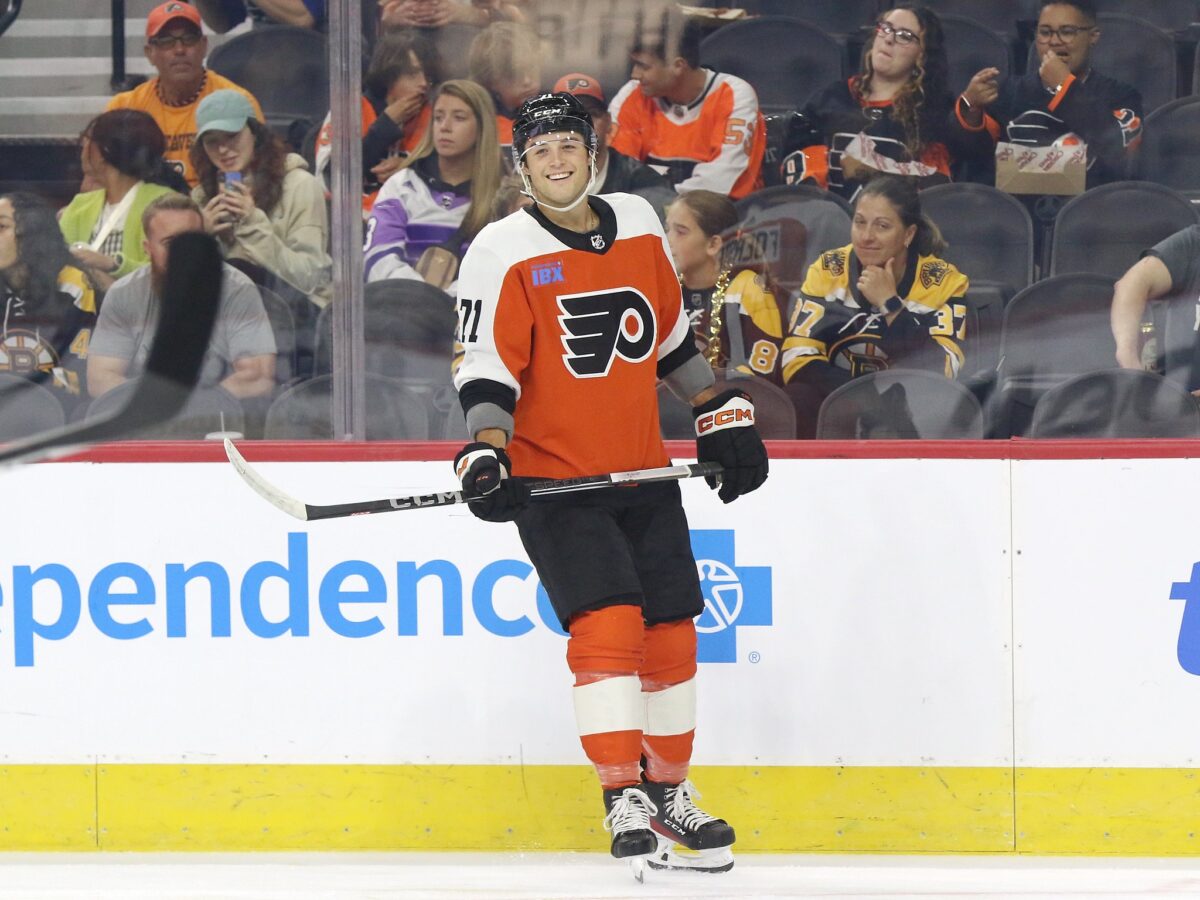In this edition of our 2023-24 Philadephia Flyers player grades, we take a look at what 22-year-old rookie Tyson Foerster was able to do. Selected with the 23rd-overall pick in the 2020 NHL draft, the Orange and Black have had some high hopes for the winger for quite some time now.
Related: Flyers’ Tyson Foerster Deserves Calder Trophy Consideration
Foerster is a difficult player to gauge because his play greatly varied from one part of the season to the next. Looking at his age-22 campaign overall, how did he fare?
Foerster Flashes Scoring Potential
Entering this season, the expectation for Foerster was that he would do what he was drafted for — score goals. Finishing with 20 of them and 33 total points in 77 contests, it wasn’t exactly the offensive breakout the Flyers needed. Still, he had his moments of brilliance.
From Jan. 27 through Mar. 30, a 22-game span, he had 13 goals. For about a quarter of the season, Foerster was the best goal-scorer the Flyers had on the roster, and nobody else came particularly close. He seemed like a more confident shooter, showcasing his deadly shot in his arsenal. The Flyers don’t have many players with that talent, so he stuck out.
The good news is that Foerster can shoot, even if he regressed in April with zero goals. Rookies will generally be pretty inconsistent, and that’s okay. At his absolute best, he was arguably the top player the Flyers had, and he was that for an extended period. With more NHL experience, his offensive game should only continue improving and be more sustainable throughout the season.
Interestingly, Foerster only had two assists in his last 37 contests. He was doing much more shooting at his best offensively than creating chances for other players. It’s not like he wasn’t creating at all, though. While he has a lethal shot, the playmaking side of his game might end up being a strength of his. Some more growth could help unlock that. Once the scoring comes more naturally to him, he can learn to involve his teammates more.
Finding Other Ways to Contribute to the Flyers
The reason for Foerster’s lack of offensive contributions for much of the season is pretty easy to explain. Head coach John Tortorella got him outside of his comfort zone a little bit, not always looking for that gorgeous snipe all of the time. Instead, he was in the corners grinding for pucks and trying to get the cycle game going. This probably hindered the offensive upside of the Flyers, but the youngster proved to his coach that he could handle various offensive situations.
Since Foerster shines the most when he has open space, actively taking that away and making him play in tighter areas hurts his scoring ability. Ironically, playing on the top line early in the season was great for his on-ice stats. Though he wasn’t scoring goals, he was getting borderline elite on-ice results. Once he was allowed a little bit more freedom, that’s when the scoring started.

Before February, Foerster had an expected goals against per 60 (xGA/60) of just 2.16 at even strength. Among the 127 forwards with an average even-strength ice time of 14 minutes or more in that span, he ranked second in the statistic. Tortorella essentially made him play low-event hockey as a top-line forward, and it worked to the tune of a 54.7 expected goals percentage (xGF%) from his season debut through the All-Star Break. During this span, he had just nine goals in 49 contests. It helped the team win games, so his sacrifice was worthwhile.
Once Foerster started to have more success in the goals department and had a little more freedom, that’s when his on-ice stats went downhill. He had a 44.1 xGF% after the All-Star Break, so he never had a dominant all-around game at once. Whether being a shutdown winger or a scoring one, he was always contributing somehow.
Foerster’s Final Grade
There were some ups and downs for Foerster, but overall, he passed the eye test on all counts. His puck luck was a little bit dry early on, while some of the finishing from his linemates ended up being the same later on. Numbers aside, he seemed to fit in quite nicely for Philadelphia and was a genuinely good top-six option for them all season long.
Despite being a younger player, Tortorella treated Foerster quite nicely, never using him as an example or being hard on him in the slightest. He wasn’t exceptional overall, but Foerster does deserve a high grade. He earns a B-plus in his first full season with Philadelphia.
In the future, Foerster could have top-line potential for the Orange and Black. Playing on the first line frequently with some decent success so early in his career suggests he should be an even better fit for that spot in 2024-25 and beyond. He could have a star ceiling in the NHL.